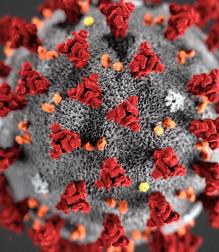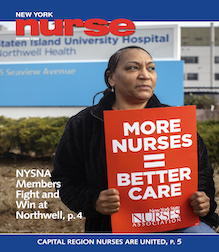The intent of this position statement is to acknowledge domestic violence as a major public health issue and declare the registered professional nurses’ ethical duty to the victims and community in addressing this concern.
DEFINITIONS
Domestic violence or intimate partner violence is a pattern of coercive behavior used to establish and maintain power and control over an intimate partner, ex-partner or family member, inclusive of emotional, psychological, physical, or sexual behaviors committed against individuals regardless of gender or sexual orientation (New York State Coalition Against Domestic Violence, 2011).
Intimate partners are defined as current or former spouses, boyfriends, or girlfriends (Truman & Rand, 2010).
According to the Centers for Disease Prevention and Control (CDC), 2009, intimate partner violence (IPV) includes four types of behavior:
- Physical violence is when a person hurts or tries to hurt a partner by hitting, kicking, or other type of physical force.
- Sexual violence is forcing a partner to take part in a sex act when the partner does not consent.
- Threats of physical or sexual violence include the use of words, gestures, weapons, or other means to communicate the intent to cause harm.
- Emotional abuse is threatening a partner or his or her possessions or loved ones, or harming a partner’s sense of self-worth. Examples are stalking, name-calling, intimidation, or not letting a partner see friends and family (CDC, 2009, p. 1).
POSITION
It is the position of the New York State Nurses Association that:
- Domestic violence is unacceptable (New York State Coalition Against Domestic Violence, 2011).
- Domestic violence is a complex issue requiring a balance between protecting the victim’s right to choice, confidentiality and personal safety, with that of promotion of assistance for the perpetrator and all others affected by the acts of violence (New York State Coalition Against Domestic Violence, 2011).
- Registered professional nurses have an ethical duty to identify and minimize risks associated with domestic violence in daily practice, regardless of the practice setting (American Nurses Association (ANA), 2000).
- Registered professional nurses have the responsibility to advocate for and attend continuing educational offerings that includes screening, assessment, documentation and intervening in suspected cases of intimate partner violence (ANA, 2000).
BACKGROUND
Domestic violence, also known as intimate partner violence, remains a serious problem in the United States which exists across all demographic, socioeconomic and cultural groups (CDC, 2009, p. 1). Statistics reveal that intimate partner violence occurs at least five times more often in females than in males and females are more often to be victimized by someone they know (Rand & Truman, 2010). Although legislation exists at both federal and state levels, the New York State Coalition Against Domestic Violence (2011) notes intimate partner violence continues to occur in same sex relationships; in teenage relationships and remains the leading cause of violence against women.
At the federal level, the Violence Against Women and Department of Justice Reauthorization Act of 2005 was intended to remedy existing laws by directing financial support for services, education and intervention to the community level; improve protection of crime victims; and improve enforcement for firearm offenses and interstate travel to commit domestic violence (United States Department of Justice, 2011). New York State (NYS) law includes requirements for hospitals with maternity and newborn services to provide information concerning family violence to parents of newborns prior to discharge (N.Y. Public Health Law § 2803-p). Regulation includes requirements for hospitals to provide for screening, referral, reporting and management of suspected and confirmed cases of domestic violence (N.Y. Title 10- Health); as well as Social Service requirements for providing support and services to individuals affected by domestic violence. Additional information regarding NYS law and regulations can be found at http://www.health.state.ny.us/regulations/
Nurses, regardless of their work setting are most likely to encounter suspected abuse, which in many cases they are required by law to report. Victims of domestic violence may fail to seek care out of fear; cultural differences; dependence on abuser; feelings of failure or promises from the abuser of change (Griffin & Koss, 2002). Establishing a therapeutic relationship allows nurses the opportunity to assess for and intervene in domestic violence (ANA, 2000). Research reveals, however that education regarding screening and intervention for registered professional nurses remains a significant barrier to assessing for abuse (Stinson & Robinson, 2006).
Pregnant women and children
Kothari, Cerulli, Marcus, and Rhodes (2009) found pregnant women are more likely to experience violence; abused women are more likely to become pregnant and a women’s prenatal status will influence their decision in seeking help from criminal justice and emergency services.
In 2008, the Family Violence Prevention Fund noted that 15.5 million children are exposed to at least one occurrence of intimate partner violence within their home; and that children of mothers who experience prenatal physical domestic violence are at an increased risk of exhibiting aggressive, anxious, depressed or hyperactive behavior. Studies reviewed by Meltzer, Doos, Vostanis, Ford, and Goodman (2009) noted increased internalized and externalized problems in children who witnessed episodes of ongoing violence in their homes. Graham-Bermann and Perkins (2010) supported these findings in their research and found behavioral issues such as social, thought and attention problems increased with more exposure to violence.
Additional research demonstrates that children exposed to violence are likely to experience post-traumatic stress disorder; at a greater risk of having allergies, asthma, gastrointestinal problems, headaches and flu; and developing serious health problems as adults (Family Violence Prevention Fund, 2008). The impact of intimate partner violence on children as direct recipients has been addressed in NYS education law which requires certain individuals to provide documentation of having completed coursework regarding the identification and reporting of child abuse and maltreatment (N.Y. Education Law § 6507) .
Elder Abuse
Domestic violence impacts the elder population on multiple levels from family caretakers to outside entities, with abusive scenarios ranging from physical and psychological abuse, neglect and financial exploitation. In a literature review, Lachs and Pillemer (2004) examined risk factors, screening and intervention strategies and concluded that a multidisciplinary approach is successful in the accurate identification, confirmation and management of abused elders.
By utilizing a representative sample of individuals aged 60 and older across NYS, the Elder Abuse Prevalence Study (2011) confirmed that the incidence of elder abuse was nearly 24 times greater than the number of cases referred to intervention agencies. Psychological abuse was cited as most common, followed by financial, physical and sexual abuse self-reported by the participants as compared to documented cases. The study confirms that collection of data regarding elder abuse, with an emphasis on cross-systems collaboration, will serve in identification and management of elder abuse victims; increase focus on prevention and intervention; and promotion of public and professional awareness campaigns to direct resources to elders who face mistreatment by trusted caregivers (New York State Elder Abuse Summit, 2011). Registered professional nurses are in a position where identification of abuse in the home is crucial for prevention, early intervention and management. If the caretaker is recognized as the abuser, the nurse, using education and interpersonal skills, can provide support to both the abuser and abused. Referrals to other team members will ensure response and identification of resources available to integrate into the plan of care (Lachs & Pillemer, 2004).
Current Federal and State laws which impact elder abuse include the Elder Justice Act which provides monies for coordinating and developing leadership at the national level and grants for research and intervention strategies in long term care as well as adult protective services (Loewy, 2010). In NYS, a 2009 amendment was made to the power of attorney statute to increase the responsibilities of the agent to ensure safety of the elder’s finances (Loewy, 2010). Penal law was amended in 2008 making it a felony to defraud more than one person, when two individuals identified in that group are elderly as defined in the law (Loewy, 2010).
For more information on Elder abuse please see NYSNA's Elder Abuse, Neglect and Maltreatment Position statement at http://www.nysna.org/practice/positions/position3_10.htm
Effects of Domestic Violence
Intimate partner violence can affect the health and well-being of the victims in many ways. Physical and emotional injuries can contribute to lifelong illness, personal and social difficulties. IPV has also been linked to harmful health behaviors such as smoking, alcohol and/or drug abuse and engaging in risky sexual behaviors (CDC, 2009). Although not all individuals who experience a traumatic event develop the symptoms of post-traumatic stress disorder (PTSD).
The potential for exposure during one’s lifetime exposure to a traumatic event is estimated at 40 to 90% for the general population, while prevalence for developing PTSD is estimated at 7-12% (Astur et al., 2006). Research indicates that women who experience intimate partner violence are more likely to develop PTSD, which is associated with impaired immune function, obesity, increased risk of diabetes, increased severity of premenstrual syndrome symptoms; depression, suicide, and increased likelihood of re-abuse (Scott-Tilley, Tilton, & Sandel, 2009).
Screening
Registered professional nurses are ethically and legally bound to routinely screen and assess individuals in many settings; and to ensure the appropriate intervention and referrals are identified to help decrease potential harm (Emergency Nurses Association, 2006). Griffin and Koss (2002) suggest that women are screened in private without other family members present, and asked simple questions directed at whether they have been hurt, threatened, demeaned or frightened by their partner at any time are helpful in reducing some barriers to self-reporting the abuse. Healthcare professionals must take into account when screening and treating, that domestic violence tends to increase over time and that the most dangerous time for a woman is often when she tries to leave (Griffin & Koss, 2002).
Major barriers to assessing and intervening in suspected cases of intimate partner violence continue to exist within the healthcare system due mainly to lack of education (Stinson & Robinson, 2006). Griffin and Koss (2002) reflect that assessment for domestic violence is proportionate with educational offerings. The ANA (2000) advocates for education of registered professional nurses in the assessment, prevention, intervention and referral skills related to domestic violence.
The ANA (2000) states:
All victims of sexual assault and domestic violence require compassionate and skilled care…Women need information about the cycle of violence and resources available to assist them. Referrals should be made and plans of care developed that involve the women as partners and that foster decision-making/problem solving (p. 2).
The Joint Commission requires the development of partner violence protocols (Griffin & Koss, 2002, para. 9) and the Healthy People 2020 health objectives (IVP-39 & 40) seek the reduction of physical violence, sexual violence, psychological abuse, and stalking by a current or former intimate partner (Healthy People 2020, electronic document).
Conclusion
The lack of respect for human dignity and human rights is a core problem related to domestic violence. Healthcare professionals are often the only individuals with whom victims share their experiences and at the ethical core of all healthcare professions is the principle of nonmaleficence. This principle asserts the professional’s obligation not to inflict harm on others and is always applicable, even when the domestic violence is not considered a violation of the law, such as psychological or financial abuse. Additional clarity as to nurses’ ethical duty to victims of domestic violence is evident in the ANA Code of Ethics for Nurses.
In working with victims of domestic violence, no matter how difficult or unseemly, the ANA Code of Ethics for Nurses (2002) states the nurse respects “the inherent worth, dignity, and human rights of every individual” (p. 7) and the nurse “promotes, advocates for, and strives to protect the health, safety, and rights of the patient” (p. 12). The ANA Code also calls for nurses to collaborate with public and health professionals to promote the health needs of people, wherever they may be.
RECOMMENDATIONS
The New York State Nurses Association recommends that registered professional nurses:
- Reaffirm their professional and ethical obligation to become knowledgeable regarding the nature and dynamics of domestic violence (ANA Code of Ethics, 2002).
- Promote an environment that preserves the patient’s/victim’s right to privacy and protects the patient’s/victim’s right to make autonomous decisions (ANA, 2000).
- Develop cultural competence for more effective screening, care and counseling of individuals affected by domestic violence (Griffin & Koss, 2002).
- Become educated in the skills necessary for effective detection, prevention and intervention of domestic violence (ANA, 2000).
- Support opportunities through education, research, and policy changes to advance societal efforts to break the destructive cycle of domestic violence (Stinson & Robinson, 2006; CDC, 2009).
- Promote universal screening for domestic violence as a routine part of taking a history by all healthcare providers (Griffin & Koss, 2002).
- Support inclusion of related content in undergraduate nursing curricula (Stinson & Robinson, 2006).
- Encourage expansion in use of sexual assault nurse examiners (SANE) and other forensic nurse examiners (ANA, 2000).
Approved by the Board of Directors on November 2, 1998; April 8, 2005; June 15, 2011.
Reviewed and revised by the expanded Council on Nursing Practice on April 1, 2005;
The Council on Nursing Practice March 14, 2011.
Note: The use of the term “patient” anywhere in this document is intended to be generic and refers to the recipient of nursing care.
REFERENCES
American Nurses Association. (2001). Code of ethics for nurses with interpretative statements. Washington, DC: Author.
American Nurses Association. (2000). Position statements: Violence against women. Retrieved from http://www.nursingworld.org/readroom/position/social/scviolnw.htm
Astur, R., St Germain, S., Tolin, K. D., Ford, J., Russell, D., & Stevens, M. (2006). Hippocampus function predicts severity of post traumatic stress disorder. Cyber Psychology Behavior, 9(2), 234–240. doi:10.1089/cpb.2006.9.234
Centers for Disease Control and Prevention (2009). Understanding intimate partner violence. [Fact Sheet]. Retrieved from http://www.cdc.gov/violenceprevention/pdf/IPV_factsheet-a.pdf
Emergency Nurses Association. (2006). Intimate partner and family violence, maltreatment, and neglect. [Position Statement]. Retrieved from http://www.ena.org/SiteCollectionDocuments/Position%20Statements/Violence__Intimate_Partner_and_Family_-_ENA_PS.pdf
Family Violence Prevention Fund. (2008). Facts on children and domestic violence. Retrieved from http://www.endabuse.org/userfiles/file/Children_and_Families/Children.pdf
Graham-Bermann, S. A., & Perkins, S. (2010). Effects of early exposure and lifetime exposure to intimate partner violence (IPV) on child adjustment. Violence and Victims, 25(4), 427-439. doi:10.1891/0886-6708.25.4.427
Griffin, M. P., & Koss, M. P. (2002). Clinical screening and intervention in cases of partner violence. Online Journal of Issues in Nursing. Retrieved from http://www.nursingworld.org/ojin/topic17/tpc17_2.htm
Healthy People 2020 Proposed Objectives. (2010). Injury and violence prevention. Retrieved from http://healthypeople.gov/2020/topicsobjectives2020/objectiveslist.aspx?topicid=24
Kothari, C. A., Cerulli, C., Marcus, S., & Rhodes, K. V. (2009). Prenatal status and help seeking for intimate partner violence. Journal of Women’s Health, 18 (10). doi:10.1089=jwh.2008.1310
Lachs, M. S., & Pillemer, K. (2004). Elder abuse. Lancet, 364, 1263-72.
Loewy, E. (2010). Progress in prosecuting financial abuse of older New Yorkers. Capital Commons Quarterly, 4(3), 10-12. Retrieved from http://www.albanyguardiansociety.org/pdf/CCQ_09172010.pdf
Meltzer, H., Doos, L., Vostanis, P., Ford, T., & Goodman, R. (2009). The mental health of children who witness domestic violence. Child & Family Social Work, 14, 491-501. doi:10.1111/j.1365-2206.2009.00633.x
N.Y. Education Law § 6507 (2011).
N.Y. Public Health Law § 2803-p (2011).
New York State Coalition Against Domestic Violence. (2011). Principles for practice. Retrieved from http://nyscadv.org/principles.htm
New York State Elder Abuse Summit. (2010 March). Under the Radar: New York State Elder Abuse Prevalence Study. Symposium held at Samaritan Hospital, Troy, NY.
Scott-Tilley, D., Tilton, A., & Sandel, M. (2009). Biologic correlates to the development of post-traumatic stress disorder in female victims of intimate partner violence: Implications for practice. Perspectives in Psychiatric Care, January 2010, 46(1), 26-36.
State of New York, Official Compilation of Codes, Rules and Regulation. Title 10 – Health, § 405.9 (15e).
Stinson, C. K., & Robinson, R. (2006). Intimate partner violence: Continuing education for registered nurses. The Journal of Continuing Education in Nursing, 37(2), 58-62.
Truman, J., & Rand, M. (2010). Criminal victimization, 2009, (NCJ 231327) U.S. Department of Justice, Bureau of Justice Statistics. (2010). National crime victimization survey criminal victimization. Retrieved from http://bjs.ojp.usdoj.gov/content/pub/pdf/cv09.pdf
United States Department of Justice. (2011). The facts about violence against women. Retrieved from http://www.ovw.usdoj.gov/docs/vawa.pdf
For more information on nursing practice, contact NYSNA's Education, Practice and Research Program at 518.782.9400, ext. 282 or by e-mail.




